Pruning, Flowers
Much of Pruning is About Renewal
Why am I spending so much time pruning these days? To keep plants manageable and healthy, of course. But also so that flowering and fruiting trees, shrubs, and vines keep on flowering and fruiting. “Renewal pruning” is what does this.
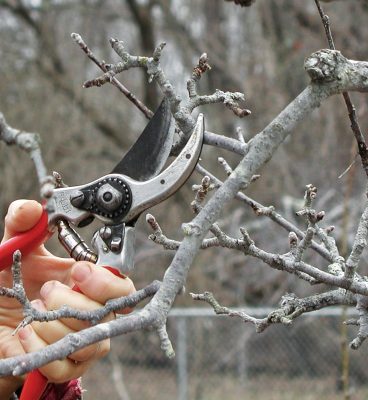
Pruning apple spur
As plant stems age, they — like all living things — become decrepit, no longer able to perform well. But any plant’s show or productivity can be kept up if stems that are too old are periodically lopped back, which promotes growth of new, young, fecund stems. That’s all there is to renewal pruning.
Ah, but the devil is in the details. One important detail is how old is “too old.” That depends on the flowering and fruiting habit of the plant.
Near one extreme would be pear trees. Along pear stems grow stubby growths, called “spurs,” which bear the tree’s flowers and fruits.

Young pear spur
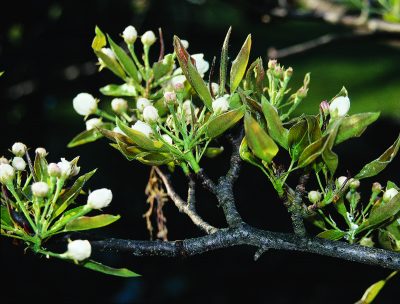
Older pear spur
These stubby growths grow only an inch or less each year. Over time, spurs branch and these small branches, in turn, branch to create what look like miniature trees perched along the tree’s stems.
A pear’s individual spur can remain vibrant for about a decade, so little pruning is needed annually. But eventually, even a spur grows old and decrepit. I renewal prune my pears by cutting back some of the stubby parts of a spur system to coax out younger stubby growths or even by lopping back a whole stem on which they sit, stimulating new stem growth on which will develop new spurs.
Near the other extreme in pruning would be an everbearing raspberry plant, which bears flowers and fruits on young shoots arising from ground level. Those bearing stems are very short lived. One way to prune an everbearing raspberry plant would be to lop all stems to the ground each winter. Having borne, those stems are aging rapidly, and pruning stimulates a flush of new, bearing stems that will come up from ground level in spring.
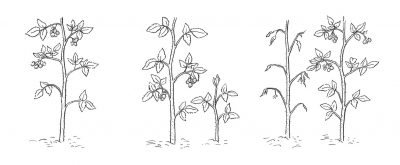
Everbearing raspberry growth habit
(Not to muddy the waters, but everbearing raspberry stems actually bear late in their first summer of growth, then again in midsummer the following year, so stems could be left one more season to bear that second crop. After that, though, the two-year-old stems need to be cut back. They die after their second year anyway.)
Pear and everbearing raspberry represent two extremes in bearing habit and, hence, method of renewal pruning. Other plants lie somewhere on the spectrum between these extremes. Where? It depends, as I wrote, on their particular bearing habit. For instance, blueberry stems are most productive on stems up to 6 years old, gooseberries on stems 2 and 3 years old, and grapes and peaches on stems one year old. So I cut away stems older than 6 years old from my blueberry bushes, stems older than 3 years old from my gooseberry bushes, and stems older than a year old from my grape vines and peach trees.
For other plants grown for either their flowers or their fruits, find out how to renewal prune them by watching how they bear for a season or more, or get the information from a book (such as my book, The Pruning Book).
A Workshop
If you’re interested in delving deeper into pruning, I will be holding a pruning workshop here on my farmden in New Paltz, NY on March 28, 2020. For more information about this workshop, please go to https://leereich.com/workshops.
Not Forgetting the Flowers
Flowers are at a premium this time of year. Here on my farmden, the only flowers blooming outdoors are winter aconite and snowdrops.
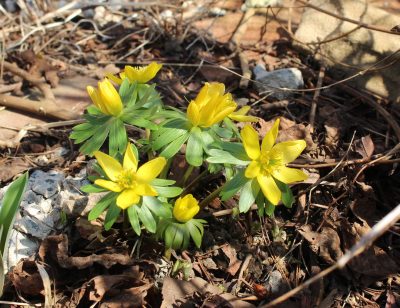
Winter aconite
(Typically, my ‘Arnold’s Promise’ witch hazel would be bursting into bloom about now but a few years ago I performed dramatic renewal pruning to reduce the size of the plant. No special technique was involved other than lopping the whole plant to ground level. Witch hazel’s stems bear flowers for many, many years, so don’t need regular pruning; it does take a few years, though before stems are old enough to begin bearing.)
Indoors, plants sense the lengthening days of brightening sunlight. African violets have been blooming for a couple of weeks and will go on doing so for weeks to come.

The same goes for the Odontoglossum pulchellum orchid, whose stems are weighed down with small waxy white, fragrant flowers.
One surprise was a butterfly bush that was in a large pot that I had brought indoors for winter. This plant enjoys bright sun and hot days, neither of which it receives indoors — it has, nonetheless, managed to cough forth, so far, a singe blue blossom. I stick my nose into the flowers, close my eyes, and inhale, and it’s midsummer.
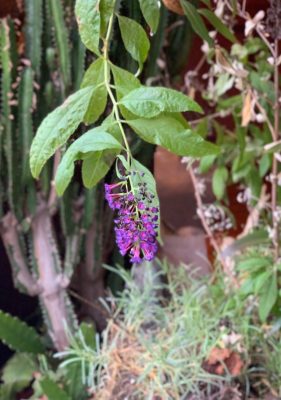
Butterfly bush, indoors
Most dramatic are the humongous, fire engine red bloom of an amaryllis plant. It is gaudy, but appreciated anyway.
My favorites are the white blossoms now opening on Meyer lemon. The blossoms aren’t all that showy but their fragrance is heady and heavenly. No need even to get my nose up close.
I did catch one other bit of welcome color outdoors: my first sighting of bluebirds. The day is gray but the bluebird, to quote Thoreau, was “carrying the [blue] sky on its back.“


Thanks for sharing this valuable info.
Sue
I love reading you commentary esp the quote as well.
Hello ! What was the name of your cherry tree with fruit and beautiful blossoms?
Dear Dr. Reich,
Can you advise me on a pruning dilemma? To my considerable joy, a Nikita’s Gift persimmon bore fruit in my garden last fall. At the top of the tree are two leaders, one which bore fruit, and one that didn’t.
1. I could remove the leader that did not bear fruit and cut back the leader that did to promote lateral branching.
2. I could use a separator to coax the leader that did bear fruit into a lateral, cutting it back a foot or more. I could then maintain the other branch as the leader, cutting that one back about a foot.
Which option would you choose, and why? Is there an option I am not seeing?
Regards,
Sheera
Either option would be good. Did Nikita’s Gift taste good? Where are you growing it?
I am growing ‘nikita’s gift’ in my tiny backyard in Metuchen, NJ, in northern Zone 7. The fruit were best in November. The persimmon is a cross between our native persimmon and an Asian persimmon and, as you can tell from the cultivar name, hybridized at the Nikita Botanical Gardens in Yalta, Ukraine. The fruit were best in November. Sweet but somewhat dry compared to a supermarket persimmon (hachiya). I was so pleased I planted a ‘hachiya’ and a ‘saijo’ seven feet away. I’m trying to convince the county ag agent this is a viable farmers’ market crop in our area.
How do you keep track of the age of the blueberry stems? Or is this something you can generally tell by looking at them (not their precise age, but that it’s time for them to go). Does this apply to dwarf blueberry bushes as well?
I mark the stems each year with a Sharpie . . . NO! Just kidding. The ones to remove are some of the thickest, with the oldest looking bark.Generally, a stem is on the downhill when it’s thicker than about an inch. Dwarf blueberry? Not sure what that means. Lowbush blueberries are dwarf, growing only 12-18″ high. You’ll learn how to prune them on March 28th.
Dear Lee, I love your posts . You are “Urim Vetumim” (I count on you to google it) in your area.
I wish you were around in Israel now, we have had an exceptionally rainy year and our nature is bursting in blossom – flowers everywhere including the desert
Shalom to you all
Googled it and still not exactly sure about it. But I think I can say “thank you.” Rainy. It wasn’t rainy when I was there back in early November. But that was last year.
I am looking to add a persimmon to my yard, but I’m running out of space! Do you think I would get fruit from an espalier trained Mohler?
Mr. Reich – This is great, thanks!
Quick questions… I planted some pears and shipovas last fall. The sizes range from pencil to thumb thickness. In your pruning book you suggest central leader or modified leader for pears. Do I understand that an open center form is not advisable for these trees? I’m hoping to keep the plants relatively small (they are on dwarf or semi-dwarf rootstocks), perhaps using the pruning techniques promoted by Ann Ralph.
So, in short, would it be advisable to prune the main stems at knee height on these baby trees in pursuit of the open center form? Or would another technique be advisable, considering my hope to keep the trees relatively small?
Thanks so much!
I recommend central leader for those trees because they’re so inclined to naturally grow that way. They could be coaxed into open center by pruning and branch bending/spreading.
I see. So, it’s possible to achieve an open center form, but to do so you’d have to work against the tree’s natural inclinations. I’m brand new to fruit trees (these are my very first), so I would think working with and not against the tree’s inclinations would be advisable for a novice.
Thank you for the response and happy pruning!